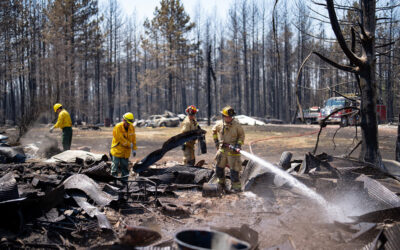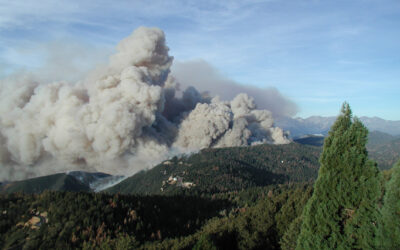On a sunny Tuesday in Anaheim in the parking lot of a firefighter training center, a tiny house burst into flames while its neighbor survived.
The fiery display was part of a demonstration showcasing the effectiveness of wildfire defense strategies, and it could serve as a road map for Pacific Palisades and Altadena as the communities begin to rebuild in the wake of the devastating January fires.
The event — co-hosted by the nonprofit research group Insurance Institute for Business & Home Safety and the California Building Industry Assn. — pitted two tiny homes, about the size of sheds, against a fire. One was built to typical standards, and the other was built above and beyond, employing a handful of fire-mitigation techniques.
Predictably, the unprotected home met the fate that thousands of structures did during the windy and dry Jan. 7 disaster.
First, firefighters used drip torches to simulate embers landing around it. Four industrial fans provided the wind, spreading the fire across dry wood mulch onto small shrubs lining the house’s exterior.
Five minutes in, the shrubs crackled as a stack of firewood on the side of the home — a common storage place for properties with wood-burning fireplaces — ignited. Soon, the flames crawled up a tall juniper bush planted on the side of the home, spreading flames onto the exterior wall and roof, shortly before a wood fence burst into flames.
The vinyl rain gutter sagged and melted, its plastic material flapping in the wind like a flag, and the window shattered shortly after, letting the flames enter the interior. Fifteen minutes in, the fire burned from the inside out, roaring through the walls and roof. The home’s tan color burned to black, and smoke billowed hundreds of feet into the sky.
After twenty minutes, the house was engulfed in an inferno before the frame gave way, collapsing into a smoking heap of charred debris.
The wildfire-prepared home had a perimeter of cement pavers, surrounded by gravel, and no bushes against the house. The mulch blew onto the gravel and burned out. A few hydrangeas were singed five feet from the walls of house, but the home was unscathed.
“This is a tale of two homes,” said Anne Cope, chief engineer for the insurance institute.
Roy Wright, the company’s chief executive, said the burned home showcased architectural features all too common across properties in wildfire-prone areas: plastic gutters, open eaves and flammable landscaping surrounding the home such as juniper, bamboo or eucalyptus.
“We’re not going to eliminate wildfires, but we can restrict their reach,” Wright said. “The easiest way starts at home.”
The main emphasis was what fire-prevention specialists call Zone 0: the first five feet of defensible space surrounding a structure. To stop a fire in its tracks, firefighters suggest removing all landscaping from the 5-foot perimeter and replacing fire-prone materials such as grass or mulch with cement or brick.
In contrast to the one that burned, the fire-protected house featured metal gutters, fiber cement siding, enclosed eaves, a metal fence, metal patio set of a table and chairs and cement pavers. When torched with embers, the fire burned up to the 5-foot perimeter and then halted.
“You can still have plants, just keep them five feet away from your house,” Wright said.
Wright visited Pacific Palisades and Altadena a week after the fires to analyze how they spread so quickly from house to house and found that homes generally burned in clusters, which suggests that houses either helped or hurt others around them.
If a house was a century old and not up to code, it often burned quickly and passed the fire on to its neighbors, he said. But if a house was built with fire-prevention in mind, with defensible space, fire-resistant materials, enclosed eaves and mesh coverings over vents, in some cases, it served as a shield for the houses downwind.
Modern fire-prevention strategies already are being implemented in new master-planned communities in Southern California, where home builders have the hindsight of previous disasters and implement tighter building codes. A recent success story is Orchard Hills, which survived a 2020 blaze unscathed due to meticulous planning and specialized home design.
But L.A.’s housing stock is generally older, and many homes scattered across the region’s hills and mountains are sitting ducks — architecturally vulnerable if a fire sweeps through. That’s why Wright stresses clearing out Zone 0, since it’s the quickest, cheapest way to make sure that if a fire comes to your door, you’re not fueling it.
“We need to do what we can to narrow the path of destruction and give firefighters a chance to beat it down,” Wright said.
This story originally appeared in Los Angeles Times.
©2025 Los Angeles Times. Visit latimes.com. Distributed by Tribune Content Agency, LLC.




